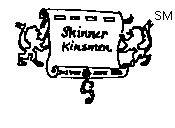

- Volume 2 Number 2
- Spring 1985
Dr. Elisha Skinner
Thanks to William Weiler for transcription of this article.
by Barbara Dunn Hitchner
E84.1026.01-05
Elisha (6), Timothy (5), Ezra (4), John (3), Thomas (2) Thomas (1) of Malden
Dr. Elisha Skinner, distinguished citizen, whose abilities and steadfastness of purpose were invaluable to the broad countryside he served as physician, churchman, tavern
He had reached a middle-aged 45 years when, in 1787, a year prior to the town's incorporation, he settled in Old Orrington. His former home was Mansfield, Massachusetts. There he had studied medicine and from there he had enlisted in the Revolution as surgeon's mate. He advanced rapidly to the rank of surgeon in General Marshall's regiment, a post he held to the war's end. In private life he followed the same profession being the first settled physician on Penobscot River above Fort Pownal, and for many years the only one.
His position in the community can be gauged by the settlers' confidence in him. He was selected in April and again in October, 1790, to go to the General Court with a petition relating to the land -- "each inhabitant to pay three shillings for Dr. Skinner's charge.'
At this time, in that area of Old Orrington, later set off as Brewer, there was no organized church within a radius of 50 miles. A small band of citizens gathered to explore the possibility of creating a religious organization. Imbued with a deep spiritual zeal, Dr. Skinner was numbered among them and served as scribe for the meeting. Into this project of `settling the gospel" among them he plunged wholeheartedly. As of September, 1800, the First Congregational Church, the `Mother Church' of the upper river, with a membership of at least thirteen persons, was organized. For many years he served as one of the Deacons and was strongly identified with it. William Hasey, of Bangor, records: --".. .having an overwhelming sense of God's infinite goodness in me...I presented myself to the Old Orrington Church at Dr. Skinner's in Brewer.. .and was admitted to the church.'
Good Deacon Eliashib Adams, in his Autobiography, speaks very frankly: -`Soon after I came to Bucksport (1803), I walked up to Bangor. ...I should have remained there had it not been that there were no religious privileges. It was a mere Sodom, with Lot dwelling in it. ...I was so disgusted with the character of the place, that for several years, when my business made it necessary for me to remain over night, I used to cross the river to Orrington and put up at Dr. Skinner's, who, with his wife were both pious and intelligent.
The truth of history requires mention that Dr. Skinner, being a tavern keeper, sold intoxicating liquors. Although he enforced the Blue Laws, sometimes his customers were boisterous and quarrelsome.
It was a welcome abode for travelers. When Park Holland and his assistants, Jonathan Maynard and John Chamberlain, had completed their survey of the Old Indian Purchase, Chamberlain closed his field notes with this statement:
- --"Monday, Nov. 2nd. 1797. Maynard and I started down river with one of the crew as boatmen, and passed the night at Dr. Skinner's, an old brother officer.'
As a civilian, Dr. Skinner continued his interest in military affairs. Under the command of his old friend, General Blake, he was surgeon for the Old Orrington militia. During the spring of 1814 when the British were threatening the Maine coast, he agreed to serve on Brewer's Committee of Safety.
In the early fall of that year came the disastrous Battle at Hampden. Even as the ships moved up the Penobscot there was effort on the part of the British to inflict random damage. Minutes of the Methodist Quarterly Conference report: - "September 3, 1814. The British troops coming up the river prevented Q. M. They shot a cannon ball through the meeting house this day. After the British were established at Castine there were further acts of annoyance and pillage. There is a tradition that pulpit furniture from the "Mother Church" was carried to Castine. Among the homes pilfered was that of Dr. Skinner. In making an inventory of his loss he was most concerned to discover his Family Bible missing. In a few days it was found, discarded, at the ferry, salvaged and returned to him. Today it is cherished by a lineal descendant, General Ralph B. Skinner of Auburn, Maine.
Of Elisha Skinner's varied activities, the one with which his name has remained most closely associated is Rising Virtue Lodge No. 10, A.F. & A.M. It could well have been his most absorbing interest. At first it seems a little surprising that none of his immediate family continued his active interest. A little research indicates that two sons died in their early twenties and other close relatives removed to Corinth, Exeter and Garland. It is within the range of possibility that they were members of Lodges elsewhere. But the Skinner name continues on Rising Virtue Rolls. John B. Skinner, Jr. (raised 1920) and his son, John B. Skinner, III (1939) are distantly related to Dr. Elisha Skinner. The latter is presently an active member.
Born in 1742, Elisha Skinner crossed the threshold into Life Eternal in 1827 when the years of his earthly life numbered eighty
signed, Barbara Dunn Hitchner
"This article was written for Rising Virtue Lodge and John B. Skinner, III. It was read at lodge and then filed in the archives."